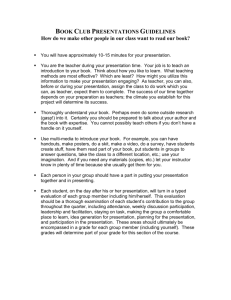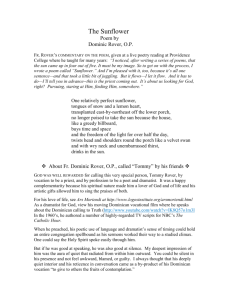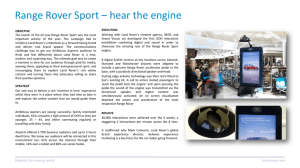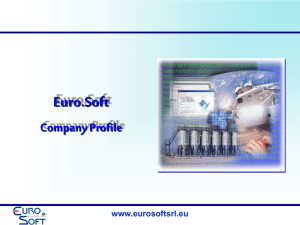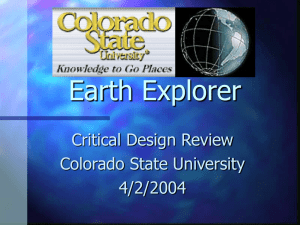R Science Autonomy for Rover Subsurface Exploration of the Atacama Desert
advertisement
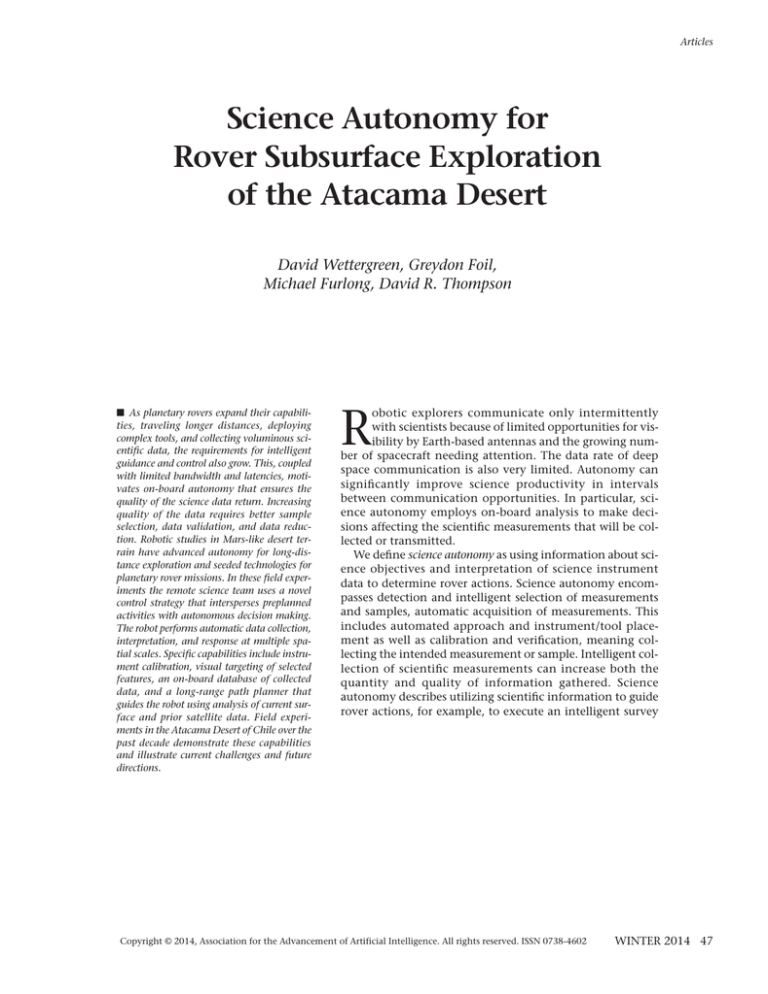
Articles
Science Autonomy for
Rover Subsurface Exploration
of the Atacama Desert
David Wettergreen, Greydon Foil,
Michael Furlong, David R. Thompson
n As planetary rovers expand their capabilities, traveling longer distances, deploying
complex tools, and collecting voluminous scientific data, the requirements for intelligent
guidance and control also grow. This, coupled
with limited bandwidth and latencies, motivates on-board autonomy that ensures the
quality of the science data return. Increasing
quality of the data requires better sample
selection, data validation, and data reduction. Robotic studies in Mars-like desert terrain have advanced autonomy for long-distance exploration and seeded technologies for
planetary rover missions. In these field experiments the remote science team uses a novel
control strategy that intersperses preplanned
activities with autonomous decision making.
The robot performs automatic data collection,
interpretation, and response at multiple spatial scales. Specific capabilities include instrument calibration, visual targeting of selected
features, an on-board database of collected
data, and a long-range path planner that
guides the robot using analysis of current surface and prior satellite data. Field experiments in the Atacama Desert of Chile over the
past decade demonstrate these capabilities
and illustrate current challenges and future
directions.
obotic explorers communicate only intermittently
with scientists because of limited opportunities for visibility by Earth-based antennas and the growing number of spacecraft needing attention. The data rate of deep
space communication is also very limited. Autonomy can
significantly improve science productivity in intervals
between communication opportunities. In particular, science autonomy employs on-board analysis to make decisions affecting the scientific measurements that will be collected or transmitted.
We define science autonomy as using information about science objectives and interpretation of science instrument
data to determine rover actions. Science autonomy encompasses detection and intelligent selection of measurements
and samples, automatic acquisition of measurements. This
includes automated approach and instrument/tool placement as well as calibration and verification, meaning collecting the intended measurement or sample. Intelligent collection of scientific measurements can increase both the
quantity and quality of information gathered. Science
autonomy describes utilizing scientific information to guide
rover actions, for example, to execute an intelligent survey
R
Copyright © 2014, Association for the Advancement of Artificial Intelligence. All rights reserved. ISSN 0738-4602
WINTER 2014 47
Articles
Figure 1. Zoë in the Atacama Desert.
or mapping strategy that adapts as data is collected.
Decisions about which samples to acquire and where
and when to travel next can be based upon metrics of
information gain. Similar metrics can also be used to
prioritize science data for download. Intelligent compression strategies use knowledge or models of content to interpret and summarize in a compact form.
The ultimate goal of science autonomy is to embody
sufficient understanding, quantified by models and
metrics, so that rovers can independently choose
actions that best support the scientific investigation
in which they are engaged. Rovers will take their
goals and guidance from scientists, but when isolated they should make scientifically rational decisions
and when in communication they should provide
the most relevant information possible.
Science autonomy is especially valuable for surface
rover operations because missions have finite lifetime
and rarely revisit sites after the first encounter — the
rover must make good decisions and get it right the
first time. Recent demonstrations on spacecraft show
increasingly sophisticated science autonomy capabilities. Milestones include target tracking during the
48
AI MAGAZINE
Deep Impact comet flyby (Mastrodemos, Kubitschek,
and Synnott 2005); target detection and response by
the Mars Exploration Rovers (Castaño et al. 2008;
Estlin et al. 2012); and spectral detection, discovery,
and mapping by the EO-1 spacecraft (Chien et al.
2005; Davies et al. 2006; Doggett et al. 2006; Ip et al.
2006; Thompson et al. 2013). At the same time, new
smart instruments are beginning to incorporate
autonomous science data analysis directly (Wagstaff
et al. 2013) and provide information that can be used
to guide the rovers’ targeting and operation.
These techniques and others will enable surface
rovers to achieve multiday autonomous operations.
Currently multiday rover plans do not travel over the
horizon of yesterday’s imagery, which limits the daily science yield. However, rover navigation already
permits safe over-the-horizon traverses, and in principle a rover could autonomously survey large areas
of terrain with its full suite of instruments. In one
natural arrangement, operators would direct the
rover using waypoints determined from satellite
images, relying on rover autonomy for low-level hazard avoidance and science target selection en route.
Articles
Figure 2. Locales Visited During the 2013 LITA Field Season.
A robot could even divert its path slightly to pursue
science targets of opportunity (Woods et al. 2009).
Multiday plans could therefore make very efficient
use of communications and personnel resources,
enhancing long-distance survey missions.
The Life in the Atacama project is a NASA-sponsored effort to evaluate these techniques in the context of desert subsurface biogeology (Cabrol et al.
2007). It uses Zoë (Wettergreen et al. 2008), a rover
capable of traveling more than 10 kilometers per day
and autonomously drilling up to 0.7 meter depth
(figure 1). As a mobility platform it combines navigational autonomy with a changing payload of onboard science instruments. Previous investigations
have used a fluorescence imager capable of detecting
very specific organic compounds and neutron detectors to measure hydrogen abundance. The current
configuration incorporates a Raman spectrometer, a
visible near infrared point spectrometer, and navigation and science cameras. During a series of experiments in the summer of 2013, scientists guided Zoë
remotely through the desert while exploring its geology and biology.
This article describes the science autonomy system
developed and tested with Zoë. It performed automatic acquisition of visible/near infrared (Vis-NIR)
reflectance spectroscopy throughout the 2013 field
season. This involved a range of different autonomous decisions exercised at various spatiotemporal
scales. We begin by describing the rover platform and
instrument payload. We then discuss instrument selfcalibration, science feature detection, and targeting
capabilities. We describe larger-scale path planning
used to select informative paths between waypoints.
We also detail the operational protocols used to command the rover and the results of its autonomous
data collection. These experiments provide a case
study of science autonomy deployed continuously
over long distances. We report on system performance, lessons learned, and plans for future development.
WINTER 2014 49
Articles
mixed alluvium
mixed alluvium
mixed alluvium
mixed-toned undivided
mixed-toned undivided
mixed alluvium
mixed
alluvium
mixed-toned undivided
mixed-toned undivided
mixed-toned undivided
dark-toned rock
younger mixed alluvium
mixed-toned undivided
dark stratified material
mixed
alluvium
mixed-toned undivided
mixed-toned undivided
mixed alluvium
mixed alluvium
mixed alluvium
mixed
alluvium
mixed-toned undivided
mixed-toned undivided
mixed alluvium
mixed alluvium
mixed-toned undivided
mixed-toned undivided
mixed-toned undivided
dark-toned rock
younger mixed alluvium
mixed-toned undivided
mixed
dark stratified material alluvium
mixed-toned undivided
mixed-toned undivided
0
N
E
W
0
2
2
4
4
6
6
8
10
S
mixed
alluvium
8
Miles
Km
Figure 3. Examples of the Different Data Products.
Top: Landsat image used in traverse planning. Bottom: Geologic classification map derived from ASTER data.
50
AI MAGAZINE
Articles
Figure 4. Hazard Avoidance.
Rover Platform, Instruments,
and Operations
In typical field work, rover operations follow a daily
cycle in which a remote science team reviews the prior data, decides the next day’s navigation waypoints
and measurements, and then sends these commands
to the rover over a satellite link. This is similar to the
sporadic communications of a planetary mission.
The rover then executes its commands over the
course of the subsequent day. In the Atacama campaign, typical command cycles for Zoë cover 5–10
kilometers per day. Figure 2 shows the entire traverse
path: red dots show locations for imaging and spectral data collection, while white paddles indicate sites
of particular interest where more in-depth study is
performed.
Scientists determine the waypoints for the next
day using geologic and compositional maps produced from orbital remote sensing data. Here the
ASTER instrument proves particularly useful: its
images have a spatial resolution of 15 meters (visible)
and 30 meters (SWIR), making them capable of
resolving details such as isolated rock outcrops.
While the three visible and six SWIR bands are not
sufficient to conclusively identify mineralogical
composition, they do help discriminate the principal units of surface material and suggested representative sites to visit.
Figure 3 shows examples of the different data
products: a Landsat image with three visible bands
reveals terrain morphology and desirable outcrops,
and a multiband ASTER image provides a rough classification of mineralogical units.
The rover itself is capable of driving more than 10
kilometers per day on challenging desert terrain
(Wettergreen et al. 2008). On-board obstacle avoidance uses three-dimensional geometry from stereo
imagery to identify hazards above the ground plane
and plan local drive arcs that go around them (figure
4). Figure 5 shows the robot and the components
used by its science autonomy system. A pair of forward-facing navigation cameras provide hazard
avoidance capability through a local path planner.
The vertical drill structure delivers subsurface soil to
a microscopic imager and a Raman spectrometer
inside the rover. Analyzing the drill samples takes an
hour or more, so these are deployed judiciously at
specific locations. However, we found that autono-
WINTER 2014 51
Articles
Panoramic
camera
Spectrometer
foreoptic
Pan/Tilt
Unit
Navigation
cameras
White
Reference
Figure 5. The Main Components of Zoë’s Vis-NIR Spectrometer System.
A Raman spectrometer inside the rover measures pulverized samples from the subsurface drill.
my could play a role in improving the science data
collected by the Vis-NIR spectrometer. The spectrometer is a modified Analytical Spectral Devices Fieldspec Pro that acquires radiance spectra from 0.4–2.5
micrometers at 0.001 micrometer resolution, housed
in the rover body and connected by a fiber optic
cable to a foreoptic telescope mounted on a pan-tilt
mechanism. The foreoptic provides a 1 degree field
of view, and can be directed at specific targets in the
environment. Its field of regard spans a full 360
degrees azimuth and 90 degrees elevation. A colocated camera provides visual context to interpret the
spectra.
Zoë’s Vis-NIR reflectance data overlaps in wavelength with ASTER orbital images; it is a more spatially and spectrally refined version of the satellite
data. By visiting distinctive terrain units of figure 3,
52
AI MAGAZINE
analysts can refine the remote view with detailed
spectral information and specific mineral absorption
features. In this manner the Vis-NIR data serves as
both a validation of the orbital data and a means to
better interpret the mineralogical constraints and
context for biogeology studies. Each session of VisNIR acquisitions begins with the rover calibrating its
instrument for temperature, solar geometry, and
atmospheric conditions using a white reference target mounted on the rover deck (figure 5 inset).
Dividing the radiance from the target by the reference measurement produces reflectance data of the
form shown in figure 6. These spectra were acquired
at locations indicated in the adjacent panoramic
camera subframe, from a distance of approximately 2
meters. The reflectance values represent the fraction
of light reflected at each wavelength; more specific
Articles
0.5
II
0.45
II
I
0.4
III
Reflectance
0.35
0.3
0.25
IV
0.2
V
0.15
0.1
0.05
0
0.5
1
1.5
2
2.5
Figure 6. Panoramic Camera Subframe.
Dive spectrometer fields of view (PP24), and associated reflectance spectra.
formulations are possible (Schaepman-Strub et al.
2006), but we will use reflectance here in the ordinary Lambertian sense. This assumption should generally hold for the geologic materials of interest. Note
that the light-colored sediment area in spectra I-III is
associated with a higher average reflectance, as well
as unique spectral features such as the dip near 2
micrometers. These spectra were smoothed using
local linear regression, but some lingering noise
spikes at longer wavelengths evidence the lower signal level in these spectral regions.
Science Autonomy Methods
Zoë’s science autonomy system includes two basic
capabilities that operate on mesoscale and
macroscale features respectively. Smart targeting can
identify science features in rover navigation imagery
and use this information to point the Vis-NIR spectrometer. Adaptive path planning navigates on scales
of tens or hundreds of meters, using satellite images
to select waypoints with distinctive or novel spectra.
We describe each of these techniques in turn.
Smart Targeting
Zoë began each autonomous target selection process
by acquiring a navigation camera image. On-board
image processing then analyzed the scene to find
large contiguous regions of a desired terrain class.
Typically these classes were rough surface features
like rock outcrop or bright sediment patches with
distinctive spectral signatures. Upon finding a feasible target, the rover recalibrated its Vis-NIR spectrometer, pointed at the feature, and collected a
small 3 x 3 raster of spectra centered on the target of
interest. For context, it also acquired a high-resolution color image of the scene.
The image analysis used a random forest pixel classification system described in previous work (Foil et
al. 2013; Wagstaff et al. 2013) and adapted to the
Atacama environment. This supervised classification
method learns a mapping from local pixel intensities
to the surface class of that pixel. The model is instantiated as an ensemble of decision trees trained in
advance. At run time, the rover tested each pixel in
the new image and averaged the classification of
each tree in the ensemble. The end result was a classification map of the entire image, along with asso-
WINTER 2014 53
Articles
ciated class posterior probabilities. By subsampling
each image by a factor of four prior to classification,
processing time was less than a second on Zoë’s onboard laptop-scale CPU.
After image classification, connected components
analysis was used to identify contiguous targets. The
rover then promoted the single largest target of the
desired class for followup data collection. For each
target, a center pixel was determined using the
largest inscribed circle heuristic (Estlin et al. 2012)
and transformed to a pan-tilt angle using the
assumption of a planar terrain surface. Use of navigation camera stereo data would identify a true threedimensional position and enable more sophisticated
kinematic solutions. Here we relied on an approximate planar solution coupled with rastering to
ensure that an inaccurate pointing would still capture the target in at least one of the Vis-NIR spectra.
Scientists developed several different ways to
incorporate this capability into multiday rover operations. The first approach was a target check used in
the middle of long traverses. This only deployed the
spectrometer if a feature of interest was found at the
check point. If there was no feature in the rover’s
field of view, it would carry on without spending the
time to calibrate and deploy its spectrometer. In this
fashion, Zoë could cover long distances without
spending undue time on bare or uninteresting terrain. This strategy was also useful near the boundary
of geologic contacts where the precise location was
uncertain. A second strategy involved a paired
panorama that acted as a supplement to a commanded Vis-NIR spectral raster. Here the rover committed all time resources in advance. It calibrated its
spectrometer and acquired data in columns of five
spectra spaced at 10 degree increments directly in
front of the robot and to either side. This provided a
representative sampling of the terrain comprising the
rover’s current ASTER pixel. It then augmented this
dataset with a 3 x 3 raster centered on any target of
interest. Together, these two products gave a better
insight than either taken individually. They met the
dual needs of having representative spectra as well as
capturing distinctive (outlier) features.
Adaptive Path Planning
The science autonomy system also operates on larger scales of tens or hundreds of meters, where it analyzes satellite data to adjust its traverse path. We
model the explored environment using a standard
geographic or area mixing model where each measurement is a mixture of a small number of end-member materials. End members’ spectra combine in proportion to their physical extent on the surface. Most
scenes contain just a few end-member spectra, and
any measurement x can be reconstructed with appropriate constituents and mixing fractions. For a scene
with m end members we define the mixing fractions
to be vectors ϕ ∈ Rm. More generally we can model a
54
AI MAGAZINE
spectral image using a linear combination of library
spectra given by a d x m matrix Y. This gives the relationship x = Y ϕ.
In practice there is always residual error separating
the reconstruction from the measurement. This is
partly attributable to measurement noise, but unless
the library is comprehensive there may also be
incompleteness errors (for example, spectral features
that are expressed in the observations but not present
in the library). A library that reconstructs all spectra
well can be said to have explained the scene, and provides insight into the mineral compositions in the
remote sensing data. This intuition provides a figure
of merit for an adaptive path-planning system to
select future measurement locations. Zoë’s planner
selects locations, the measurements at which, when
used to augment the collected library Y, provide the
largest expected reduction in unmixing error. The
planner aims to visit locations that are spectrally distinctive, collecting samples that fully explain the
orbital image.
In detail, we begin with a space of candidate measurement locations L. The robot collects a library of
spectra by sampling at sites B = {b : b ∈ L }. We define
a stochastic measurement function, y = f(b) + ε with
Gaussian-distributed measurement noise ε, that
yields spectral measurements Y = {yi : yi ∈ Rd, 1 ≤ i ≤
m}. Together the observations form a spectral library,
a random m x d matrix written YB. Good measurements reduce the total reconstruction error for selected remote sensing observations given by X = {xi : xi ∈
Rd, 1 ≤ i ≤ n}. We impose a resource cost C(B) to represent limited time, power, and bandwidth; it must
not exceed a total budget β. For simplicity we will initially ignore the cost of point-to-point travel.
We define a risk function as the expected reconstruction error incurred from unmixing the remote
images with the library of spectra collected at the
surface:
R(B) = E min ∑ YBφ − x 2
φ
x∈X
(1)
for φ ≥ 0, C(B) ≤ β
Here we are taking the expectation over the rover’s
observation matrix, which is a random variable.
Computing this expectation is analytically challenging, so instead we solve the related problem:
arg min B = min ∑ XBφ − x
φ
2
x∈X
for φ ≥ 0,C ( B) ≤ β
(2)
The linear geographic mixing assumption allows us
to infer the expectation E[YB] since in situ spectra
combine in proportion to their extent on the surface.
Due to geographic mixing we can directly substitute
the remotely observed spectra as the expectated
observations. We rewrite the objective function using
remote measurements at sites B, written XB:
Articles
Future spectra
YB
Orbital
data
XA
Collected
spectra YB
Figure 7. Formulation of Adaptive Path Planning.
R ( B A) = min ∑ XB φ − x
φ
at the future candidate locations. The objective is:
2
x∈X
for φ ≥ 0,C ( B) ≤ β
(3)
This allows direct computation of the objective for
any candidate set of measurement locations.
As the robot begins to collect spectra, some elements of E[Y] become observed. The matrix ZA represents the library of spectra collected at previous
locations A = {a : a ∈ L.}. These measurements are a
realization of YA, and can be substituted into the
expectation as the library of in situ spectra grows.
Consequently the library used for unmixing consists
of (1) the actual spectra collected at previous locations
concatenated with (2) the expected spectra collected
R ( B A) = min ∑ [ Z A XB ] φ − x
φ
2
x∈X
for φ ≥ 0,C ( B) + C ( A) ≤ β
(4)
To summarize, this final form reflects the key elements of Vis-NIR surface exploration: the overall
goal of an accurate model using a handful of spectra,
reflected in the squared error term; the physical
behavior of geographic mixing, which appears as a
positivity constraint; and the overall path-length
budget β representing finite rover energy and time
resources.
Figure 7 portrays the planning process. Here the
robot has collected two spectra to form its library ZA.
WINTER 2014 55
Articles
It calculates the expected risk of a candidate path
using remote sensing data at locations XB as a proxy
for future measurements. In this manner, it can
greedily (or nonmyopically) construct an optimal
path. For our tests, the path planning was purely
greedy; we added waypoints one by one, inserting
them into the optimal location in the waypoint
sequence and stopping when the total Euclidean
path cost was exceeded.
During the Atacama field season we defined a
budget defined in terms of path length, typically providing 1.5 times the straight-line distance to the goal.
The time cost could be significant for longer traverses, particularly including the cost of the spectral
measurements at intermediate waypoint. For this reason, most navigation actions were driving commands with adaptive navigation actions at particular
regions of special interest. When it encounters a science waypoint in the plan, the science path-planning
software finds the complete interpolating path that
minimizes spectral reconstruction error of the nineband ASTER image. It drives to the next intermediate
waypoint along that path, collects a spectrum of the
terrain, and replans the remainder using whatever
path budget remains. That remainder becomes the
next science plan, which is further refined in additional planning rounds as the rover progresses forward. In this fashion, the science planner can be fully stateless and react to new data encountered during
the traverse.
Figure 8 shows the benefit of science-aware path
planning in a simple simulation. We simulate a virtual rover traversing the famous Cuprite, Nevada,
mining district, which is known for containing many
distinctive spectral features of interest in highly
localized outcrops (Swayze et al. 1992). Here we
planned rover paths using orbital ASTER data, simulating 256 trials with random start and end points
within the scene. We also simulated high-resolution
in situ acquisitions using coregistered data from the
Airborne Visible Near Infrared Spectrometer (AVIRIS)
(Green et al. 1998).
The comparison considers four different strategies
to fill the path-length budget: a random path, which
bends the path toward randomly selected intermediate waypoints; a direct path, which begins with a
straight line and then adds ”wiggles” until the total
length is reached; an unconstrained adaptive
approach that minimizes equation 3 but without the
positivity constraint; and an adaptive approach that
enforces positivity of mixing fractions. We recomputed the reconstruction error for every trial by
applying nonnegative least squares to the collected
high-resolution spectra. Figure 8 shows each
method’s performance with a box indicating the
median and quartile of the data and the whiskers
indicating the extrema. Both adaptive methods significantly outperform the nonadaptive approaches,
with the constrained adaptive method performing
56
AI MAGAZINE
best of all. This performance boost happens because
only the adaptive systems actively pursue the isolated outcrops with unique mineralogy.
On-board the real rover, a low-level control system
is required to travel safely between these features of
interest. Consequently, Zoë has on-board navigation
software to turn high-level science waypoints, spaced
on the order of tens or hundreds of meters, into lowlevel vehicle actions like drive arcs. It uses a software
suite known as the Reliable Autonomous Surface
Mobility (RASM) package (Wettergreen and Wagner
2012) capable of local hazard avoidance and path
planning using a three-dimensional terrain representation. RASM extracts a cloud of three-dimensional
points from the stereo cameras, orients these points
relative to previously collected data, and builds a triangulated mesh. An A* search algorithm projects
drive arcs across this mesh to compute the cost of
local control actions. On longer scales, graph search
identifies the best path to the next waypoint. RASM
retains knowledge of the topology relating observation locations to their neighbors, permitting efficient
loop closure and pose estimation over long distances.
Field Season Results
We engaged smart targeting during three days of rover
operations. Table 1 shows the performance for typical
targets during these traverses. Columns indicate the
day (Sol) of operations; the action sequence number,
with TC indicating a target check, PP a paired panorama, and AT a more specific planned data collection
activity; the analysts’ post hoc interpretation of the
feature that was found; and two columns indicating
whether the result was a reasonable science target and
whether the pointing was accurate. Pointing accuracy
was evaluated based on the context image collected
with each spectrum, allowing it to be placed within
the navigation camera image.
Overall, target selection performed reliably. The
majority of targets were either rocks or patches of distinctive sediment. The only arguable failure was
when the system identified a distant car that fell into
the rover field of view. The pointing solution was
slightly less reliable, since our groundplane assumption tended to break down at the periphery of the
navigation camera image near the horizon.
Occasionally very distant targets would result in
the rover aiming its spectrometer too far into the distance. Only one scene was totally featureless — an
empty plain — and in this case the rover detected no
targets and successfully abstained from spending any
time resources.
Figure 9 shows several images from the real-time
classification. Here the system was trained to recognize rocks and high albedo soil patches, and it successfully finds these features. In the center column, a
red overlay represents the surface labeled as the
belonging to the target class. The black rectangles
Mean unmixing reconstruction error
Articles
0.04
0.035
0.03
0.025
0.02
0.015
0.01
Random path
Direct path
Adaptive
Adaptive, constrained
Figure 8. Adaptive Path-Planning Performance, in Simulation.
Sol
Action
SR
Target Found
Target Valid?
Pointing Accurate?
12
TC30
122
Rocks
OK
OK
TC31a
123
Foreground rock
OK
OK
TC31b
125
Foreground rock
OK
OK
TC32
128
Rock pile, sediment
OK
OK
AT-13-09
172
Disturbed rocks and sediment
OK
OK
PP22
166
Distant rock patch
OK
BAD
PP23
160
Distant rock patch
OK
OK
PP24
154
Foreground rocks
OK
OK
PP25
148
Foreground rocks
OK
OK
TC34
158
Foreground sediment patch / rocks
OK
OK
TC34-recon
132
None
OK
n/a
2
TC41
170
Rocks
OK
BAD
3
TC42
164
Distant rock patch
OK
BAD
4
AT-13-10
190
Car
BAD
BAD
5
PP19
216
Foreground Rock
OK
OK
TC40
183
Rock patch
OK
OK
13
14
Notes
1
Table 1. Target Detection Results from Playa Exploration Phase.
1: Aims too high for distant targets. 2: No target in scene. 3: Targeted feature not the largest rock. 4: Very distant feature. 5: Cars in frame.
show the field of view of the high-resolution followup image collected by the mast-mounted camera
(right column). Each follow-up image is accompanied
by a 3 x 3 raster of spectra. Even when the target selection was successful, we did not notice a significant difference between the on- and off-target spectra. This
may be attributed to low signal to noise. Alternatively, these features may have spectral signatures that
were very similar to the background substrate.
We deployed the adaptive navigation system successfully in two instances during the 2013 field campaign. Near the end of the field season the rover vis-
WINTER 2014 57
Articles
Figure 9. Examples of Targets Detected in Midtraverse, and Associated Followup Images.
Sediment / Rock
end
start
Playa
Figure 10. A Composite of Rover Images Showing the Playa Where Adaptive Navigation Was Evaluated.
ited a playa — a dry lakebed approximately 2 kilometers in length that was spectrally distinctive from
the surrounding terrain (figure 10). Figure 11 shows
a typical round of adaptive path planning near the
playa edge. Here the playa is visible as a bright area in
the lower right of the overhead satellite image. The
58
AI MAGAZINE
large pixels represent 15-meter ASTER data. Here
Zoë’s planned path, in blue, diverts to sample the
spectrally distinctive playa surface. The path
changed only slightly in subsequent replanning as
the rover visited each waypoint and incorporated the
new spectra into its solution.
Articles
Followup image
Detected targets
Original image
A
B
C
D
Figure 11. Demonstration of Adaptive Path Planning.
While the on-board planning gave an intuitive
and reasonable answer, the actual rover paths were
not as expected due to misregistration between
orbital data products and the rover’s on-board GPS
estimate. Postanalysis of the data revealed the real
position was offset by more than 100 meters from the
intended location, so the actual rover path spent
most of its time on the playa. In the future we will
directly address these registration errors with the use
of explicit ground control points (GCPs).
Conclusions
This work demonstrates novel techniques integrating
adaptive autonomous science activities with preplanned data collection. Zoë’s system will continue
to mature in the coming year.
WINTER 2014 59
Articles
Acknowledgments
A portion of this research was performed at the Jet Propulsion Laboratory, California Institute of Technology.
The Landsat map in Figure 3 is courtesy Ken Tanaka (USGS). The geologic
classification comes from Jeffery Moersch (UTenn). Copyright 2013. This
research is funded by the NASA Astrobiology and Technology for Exploring
Planets (ASTEP) program under grant
NNX11AJ87G.
References
Cabrol, N. A.; Wettergreen, D.; WarrenRhodes, K.; Grin, E. A.; Moersch, J.; Diaz, G.
C.; Cockell, C. S.; Coppin, P.; Demergasso,
C.; Dohm, J. M.; Ernst, L.; Fisher, G.; Glasgow, J.; Hardgrove, C.; Hock, A. N.; Jonak,
D.; Marinangeli, L.; Minkley, E.; Ori, G. G.;
Piatek, J.; Pudenz, E.; Smith, T.; Stubbs, K.;
Thomas, G.; Thompson, D.; Waggoner, A.;
Wagner, M.; Weinstein, S.; and Wyatt, M.
2007. Life in the Atacama: Searching for Life
With Rovers (Science Overview). Journal of
Geophysical Research: Biogeosciences 112(G4):
28, 2007. dx.doi.org/10.1029/2006JG000
298
Castaño, A.; Fukunaga, A.; Biesiadecki, J.;
Neakrase, L.; Whelley, P.; Greeley, R.; Lemmon, M.; Castano, R.; and Chien, S. 2008.
Automatic Detection of Dust Devils and
Clouds on Mars. Machine Vision and Applications 19(5-6): 467–482. dx.doi.org/10.
1007/s00138-007-0081-3
Chien, S.; Sherwood, R.; Tran, D.; Cichy, B.;
Rabideau, G.; Castano, R.; Davies, A.; Mandl, D.; Frye, S.; Trout, B.; Shulman, S.; and
Boyer, D. 2005. Using Autonomy Flight
Software to Improve Science Return on
Earth Observing One. Journal of Aerospace
Computing, Information, and Communication
2(4): 196–216. dx.doi.org/10.2514/1.12923
Davies, A.; Chien, S.; Baker, V.; Doggett, T.;
Dohm, J.; Greeley, R.; Ip, F.; Cichy, B.;
Rabideau, G.; Tran, D.; Sherwood, R. 2006.
Monitoring Active Volcanism With the
Autonomous Sciencecraft Experiment on
EO-1. Remote Sensing of Environment 101(4):
427–446. dx.doi.org/10.1016/j.rse.2005.08.
007
Doggett, T.; Greeley, R.; Chien, S.; Castano,
R.; Cichy, B.; Davies, A.; Rabideau, G.; Sherwood, R.; Tran, D.; Baker, V.; et al. 2006.
Autonomous Detection of Cryospheric
Change with Hyperion On-Board Earth
Observing-1. Remote Sensing of Environment
101(4): 447–462. dx.doi.org/10.1016/j.rse.
2005.11.014
Estlin, T.; Bornstein, B.; Gaines, D.; Anderson, R. C.; Thompson, D. R.; Burl, M.; Cas-
60
AI MAGAZINE
tano, R.; and Judd, M. 2012. Aegis Automated Targeting for Mer Opportunity
Rover. ACM Transactions on Intelligent Systems Technology (TIST) 3(3): Article 50.
dx.doi.org/10.1145/2168752.2168764.
Foil, G.; Thompson, D. R.; Abbey, W.; and
Wettergreen, D. S. 2013. Probabilistic Surface Classification for Rover Instrument Targeting. In Proceedings of the 2013 IEEE International Conference on Intelligent Robots and
Systems (IROS), 775–782. Piscataway, NJ:
Institute of Electrical and Electronics Engineers. dx.doi.org/10.1109/IROS.2013.6696
439
Green, R. O.; Eastwood, M. L.; Sarture, C.
M.; Chrien, T. G.; Aronsson, M.; Chippendale, B. J.; Faust, J. A.; Pavri, B. E.; Chovit, C.
J.; Solis, M.; Olah, M. R.; Williams, O. 1998.
Imaging Spectroscopy and the Airborne Visible/Infrared Imaging Spectrometer (Aviris).
Remote Sensing of Environment 65(3): 227–
248. dx.doi.org/10.1016/S0034-4257(98)
00064-9
Ip, F.; Dohm, J.; Baker, V.; Doggett, T.;
Davies, A.; Castano, R.; Chien, S.; Cichy, B.;
Greeley, R.; Sherwood, R.; Tran, D.;
Rabideau, G. 2006. Flood Detection and
Monitoring with the Autonomous Sciencecraft Experiment Onboard EO-1. Remote
Sensing of Environment 101(4): 463–481.
dx.doi.org/10.1016/j.rse.2005.12.018
Mastrodemos, N.; Kubitschek, D. G.; and
Synnott, S. P. 2005. Autonomous Navigation for the Deep Impact Mission Encounter
with Comet Tempel 1. Space Science Reviews
117(1–2): 95–121. dx.doi.org/10.1007/s11
214-005-3394-4
Schaepman-Strub, G.; Schaepman, M.;
Painter, T.; Dangel, S.; and Martonchik, J.
2006. Reflectance Quantities in Optical
Remote Sensing: Definitions and Case Studies. Remote Sensing of Environment 103(1):
27–42. dx.doi.org/10.1016/j.rse.2006.03.
002
Swayze, G.; Clark, R.; Sutley, S.; and Gallagher, A. 1992. Ground-Truthing Aviris Mineral Mapping at Cuprite, Nevada. Summaries of
the Third Annual JPL Airborne Geosciences
Workshop, Volume 1: AVIRIS Workshop. JPL
Publication 92-14, 47–49. Pasadena, CA: Jet
Propulsion Laboratory, California Institute
of Technology.
Thompson, D.; Bornstein, B.; Chien, S.;
Schaffer, S.; Tran, D.; Bue, B.; Castano, R.;
Gleeson, D.; and Noell, A. 2013.
Autonomous Spectral Discovery and Mapping Onboard the EO-1 Spacecraft. IEEE
Transactions on Geoscience and Remote Sensing 51(6): 3567–3579. dx.doi.org/10.1109/
TGRS.2012.2226040
Wagstaff, K.; Thompson, D. R.; Abbey, W.;
Allwood, A.; Bekker, D. L.; Cabrol, N. A.;
Fuchs, T.; and Ortega, K. 2013. Smart, Texture-Sensitive Instrument Classification for
In Situ Rock and Layer Analysis. Geophysical
Research Letters 40(16): 4188–4193. dx.doi.
org/10.1002/grl.50817
Wettergreen, D., and Wagner, M. 2012.
Developing a Framework for Reliable
Autonomous Surface Mobility. Paper presented at the 12th International Symposium on Artificial Intelligence, Robotics and
Automation in Space (i-SAIRAS-12), Turin,
Italy, 4–6 September.
Wettergreen, D.; Wagner, M. D.; Jonak, D.;
Baskaran, V.; Deans, M.; Heys, S.; Pane, D.;
Smith, T.; Teza, J.; Thompson, D. R.; Tompkins, P.; and Williams, C. 2008. Long-Distance Autonomous Survey and Mapping in
the Robotic Investigation of Life in the Atacama Desert. Paper presented at the 9th
International Symposium on Artificial
Intelligence, Robotics and Automation in
Space (i-SAIRAS-08), Los Angeles, CA USA,
26–29 February.
Woods, M.; Shaw, A.; Barnes, D.; Price, D.;
Long, D.; and Pullan, D. 2009. Autonomous
Science for an Exomars Roverlike Mission.
Journal of Field Robotics 26(4): 358–390.
dx.doi.org/10.1002/rob.20289
David Wettergreen is a research professor
at the Robotics Institute at Carnegie Mellon
University. His research focuses on robotic
exploration underwater, on the surface, and
in air and space; and in the necessary ingredients of perception, planning, learning
and control for robot autonomy. His work
spans conceptual and algorithm design
through field experimentation and results
in mobile robots that explore the difficult,
dangerous, and usually dirty places on
Earth, in the service of scientific and technical investigations. Much of this work is
relevant to ongoing and future space activities.
Greydon Foil is a Ph.D. student at the
Robotics Institute at Carnegie Mellon University. He is interested in large-scale mapping and planning for autonomous rovers,
with current work involving physical
process modeling for better terrain understanding.
Michael Furlong is a researcher with interests in theoretical neuroscience, decision
making, and robotics.
David R. Thompson is a researcher at the
Jet Propulsion Laboratory, California Institute of Technology. His work involves the
application of computer vision, machine
learning, and spectroscopy to robotic Earth
and planetary science. His algorithms have
run on autonomous robots and sensors
fielded in North America, South America,
the Atlantic Ocean, airborne demonstrations, low Earth orbit, and the surface of
Mars.

